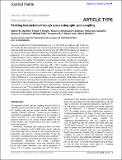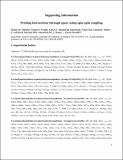Files in this item
Probing interactions through space using spin-spin coupling
Item metadata
| dc.contributor.author | Stanford, Martin W. | |
| dc.contributor.author | Knight, Fergus R. | |
| dc.contributor.author | Arachchige, Kasun S. Athukorala | |
| dc.contributor.author | Camacho, Paula Sanz | |
| dc.contributor.author | Ashbrook, Sharon E. | |
| dc.contributor.author | Buehl, Michael | |
| dc.contributor.author | Slawin, Alexandra M. Z. | |
| dc.contributor.author | Woollins, J. Derek | |
| dc.date.accessioned | 2015-03-03T00:01:38Z | |
| dc.date.available | 2015-03-03T00:01:38Z | |
| dc.date.issued | 2014-03-04 | |
| dc.identifier | 116643679 | |
| dc.identifier | 41d7166c-1ae3-49af-b451-58961ae05f76 | |
| dc.identifier | 000333580600030 | |
| dc.identifier | 84897547281 | |
| dc.identifier | 000333580600030 | |
| dc.identifier.citation | Stanford , M W , Knight , F R , Arachchige , K S A , Camacho , P S , Ashbrook , S E , Buehl , M , Slawin , A M Z & Woollins , J D 2014 , ' Probing interactions through space using spin-spin coupling ' , Dalton Transactions , vol. 43 , no. 17 , pp. 6548-6560 . https://doi.org/10.1039/c4dt00408f | en |
| dc.identifier.issn | 1477-9226 | |
| dc.identifier.other | ORCID: /0000-0002-1095-7143/work/48131808 | |
| dc.identifier.other | ORCID: /0000-0002-4538-6782/work/56638990 | |
| dc.identifier.other | ORCID: /0000-0002-9527-6418/work/56861989 | |
| dc.identifier.other | ORCID: /0000-0002-1498-9652/work/31779198 | |
| dc.identifier.uri | https://hdl.handle.net/10023/6152 | |
| dc.description | The work in this project was supported by the Engineering and Physical Sciences Research Council (EPSRC). | en |
| dc.description.abstract | The series of eight 5-(TeY)-6-(SePh)acenaphthenes (Y = Fp (2), Tol (3), An-p (4), An-o (5), Tp (6), Mes (7), Tip (8), Nap (9)) were prepared and structurally characterised by X-ray crystallography, solution and solid-state NMR spectroscopy and density functional theory (DFT/B3LYP) calculations. All members of the series, except 5, adopt a BA type configuration comparable to the parent compound 1 (Y = Ph), aligning the Te-CY bond along the mean acenaphthene plane and promoting a nonbonded Se...Te-CY 3c-4e type interaction to form to stabilise the molecule (G-dependence). 5 (Y = An-o) adopts a BC type conformation in the solid but DFT calculations show this optimises to BA. Indication of strong through-space peri-interactions between Te and Se are observed in the Se-77 and Te-125 NMR spectra, with J(Te, Se) spin-spin coupling constants (SSCCs) in the range -688 to -748 Hz. Evidence supporting the presence of this interaction was also found in solid-state NMR spectra of some of the compounds which exhibit an indirect spin-spin coupling on the same order of magnitude as observed in solution. In order to quantify the steric bulk of the aryl groups (Y), we introduce the crystallographic steric parameter (theta), the cone angle measured from the furthest H atoms lying on the edges of the cone to the Te atom located at its vertex. Modification to Y has no apparent influence over the conformation of the molecule, the degree of molecular distortion occurring in the acenaphthene backbone or the extent of 3c-4e interaction; peri-distances for all eight compounds are within 0.08 angstrom and no apparent correlation is observed between the steric bulk of Y (theta) and the Se-77 chemical shifts or J(Te, Se) SSCCs. In contrast, a good correlation is found between theta and Te-125 chemical shifts. DFT calculations performed on all members of the series confirm the comparable covalent bonding between Te and Se in the series, with WBIs of ca. 0.1 obtained. Natural bond orbital analysis shows a noticeable donor-acceptor interaction between a p-type lone pair on Se and a sigma*(Te-C) antibonding orbital, confirming the onset of 3c-4e type bonding. | |
| dc.format.extent | 13 | |
| dc.format.extent | 1142322 | |
| dc.format.extent | 647082 | |
| dc.language.iso | eng | |
| dc.relation.ispartof | Dalton Transactions | en |
| dc.subject | Peri-substituted naphthalenes | en |
| dc.subject | Centre-Dot-P | en |
| dc.subject | Nonbonded interactions | en |
| dc.subject | Distance dependence | en |
| dc.subject | Phosphorous ligands | en |
| dc.subject | X-ray | en |
| dc.subject | Acenaphthenes | en |
| dc.subject | QD Chemistry | en |
| dc.subject.lcc | QD | en |
| dc.title | Probing interactions through space using spin-spin coupling | en |
| dc.type | Journal article | en |
| dc.contributor.sponsor | EPSRC | en |
| dc.contributor.institution | University of St Andrews. School of Chemistry | en |
| dc.contributor.institution | University of St Andrews. EaSTCHEM | en |
| dc.identifier.doi | https://doi.org/10.1039/c4dt00408f | |
| dc.description.status | Peer reviewed | en |
| dc.date.embargoedUntil | 2015-03-03 | |
| dc.identifier.grantnumber | EP/J010510/1 | en |
This item appears in the following Collection(s)
Items in the St Andrews Research Repository are protected by copyright, with all rights reserved, unless otherwise indicated.


